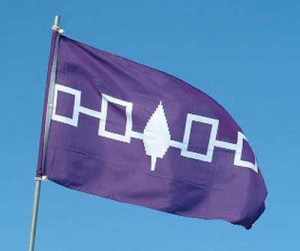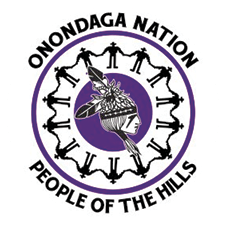 Although physically situated within the territorial limits of the United States today, native nations like the Onondaga Nation and the other members of the Haudenosaunee, or Six Nations Confederacy, retain their status as sovereign nations. Like the United States, the Haudenosaunee is a union of sovereign nations joined together for the common benefit of its citizens. Governed by a Grand Council of Chiefs who deliberate and make decisions for the people concerning issues both domestic and international, the Haudenosaunee began as a confederacy of sovereign nations aligned to deal with other native nations surrounding their lands and, later, to negotiate with Europeans when the latter came into their territories beginning in the early 1600’s.
Although physically situated within the territorial limits of the United States today, native nations like the Onondaga Nation and the other members of the Haudenosaunee, or Six Nations Confederacy, retain their status as sovereign nations. Like the United States, the Haudenosaunee is a union of sovereign nations joined together for the common benefit of its citizens. Governed by a Grand Council of Chiefs who deliberate and make decisions for the people concerning issues both domestic and international, the Haudenosaunee began as a confederacy of sovereign nations aligned to deal with other native nations surrounding their lands and, later, to negotiate with Europeans when the latter came into their territories beginning in the early 1600’s.
Onondaga Sovereignty
Sovereignty is the state of existence as a self-governing entity, and it was in this capacity that the Onondagas and other members of the Haudenosaunee sat with delegates from England, France and the Netherlands in the years prior to American independence. During the colonial era, the Haudenosaunee made at least 50 treaties with European powers, most of which were expressions of peace and friendship. Some were made to share land, but the member-states of the Haudenosaunee retained their hunting, fishing, and gathering rights within the territory that they agreed to open to settlers.
After the Revolutionary War, the 13 colonies each became independent states and began to conduct themselves as sovereign governments. Eventually, they set up a process for unified government (similar to that of the Haudenosaunee, in fact) and created the United States Constitution. The Constitution specifically vested the President or his appointed representatives with the exclusive legal right to negotiate treaties, which are agreements between sovereign nations, and gave the Senate the exclusive power to ratify those treaties. The Commerce Clause further granted Congress the exclusive authority to regulate commerce with Indian nations.
Early U.S. statesmen acknowledged the international status of Indian nations and the treaties made with them. Rufus King, one of America’s founding fathers and later a U.S. Senator from New York, equated Indian treaties with all other international treaties, such as those with Britain or France. In a February 12, 1818, letter to his son describing an Indian treaty recently rejected by the Senate, King concluded with a telling postscript: “As all Treaties, including Indian Treaties, are deemed State Secrets, until ratified and published, you must so far regard this communication as such, as not to publish the same.”
United States – Haudenosaunee Treaties
With this mutual understanding as a backdrop, the United States government entered into three major treaties with the Haudenosaunee. Interestingly, two of these treaties have never been abrogated by either side and remain in effect to this day, while a third, the 1789 Treaty of Fort Harmer, was superceded by the Treaty of Canandaigua in 1794. Validation of this treaty lies in the fact that the Haudenosaunee receives from the United States annuities from the Canandaigua Treaty, in the form of bolts of muslin cloth and a $4500 annuity allocated each year from the U.S. Treasury.
In 1871, the United States ceased treaty-making with native nations. By that time, the U.S. had entered into nearly 400 legitimate treaties with indian nations. It is the contention of the Onondaga Nation, then, that it maintains and has never relinquished either its national or collective sovereignty as a member of the Haudenosaunee. Such sovereignty was defined by the Peace Maker as belonging to those nations that accepted the Great Law, subscribed to its spiritual, moral and social mandates, and placed themselves under the authority of the Governing Councils of Chiefs. There has never been any provision for transferring that sovereignty to any other entity, nor have the traditional chiefs of the Haudenosaunee ever consented to such a transfer.
Sovereignty Defined
Like the individual states of the United States, each member nation of the Haudenosaunee retains the authority to govern its own internal affairs. Within the framework of the Great Law and its own specific laws, each individual nation reserves the right to adjudicate internal disputes, pass laws for the welfare of their own community, assess fees, regulate trade and commerce, control immigration and citizenship, oversee public works, approve land use, and appoint officials to act on its behalf. Every member of the Haudenosaunee has the authority to defend its citizens against internal and external dangers and to advocate for the peaceful resolution of conflict and the equitable distribution of collective resources.
Like the United States federal government, the Haudenosaunee is itself a constitutional government, holding the power to resolve differences between member nations and to guarantee that its members are of one mind on matters of international treaties, territorial disputes, international trade, or any other issue that affects the long-term welfare of the Confederacy. The Chiefs of the Grand Council are designated advocates of peace and hold the future welfare of the people in their hands. They are empowered to deliberate, to consider all options, to arrive at consensus, and to legislate laws that are added to the collective set of laws called the Great Law.
In the past, the chiefs, headmen and delegates of each nation were involved in the negotiation and acceptance of the terms of treaties with European governments, and later with the United States government. These treaties were then presented to the Grand Council for approval. If accepted, a treaty came to represent the legal relationship between the United States and the traditional nations.
Haudenosaunee sovereignty was not granted by the United States, any more than U.S. sovereignty was granted by the English crown in the eighteenth century. Sovereignty is an inherent right that, in the case of the Onondaga Nation, was established with the formation of the Haudenosaunee and adoption of the Great Law of Peace.
The Onondaga Nation has had and continues to possess sovereign authority, both as a nation and as part of the Haudenosaunee. With such sovereignty comes the power to pass laws, make treaties, and act on behalf of the Onondaga people in relations with other sovereign nations. It is an authority that the Nation and its designated representatives take very seriously.
Read also: Rejection of the 1924 Citizenship Act by Joseph Heath, General Counsel for Onondaga Nation
